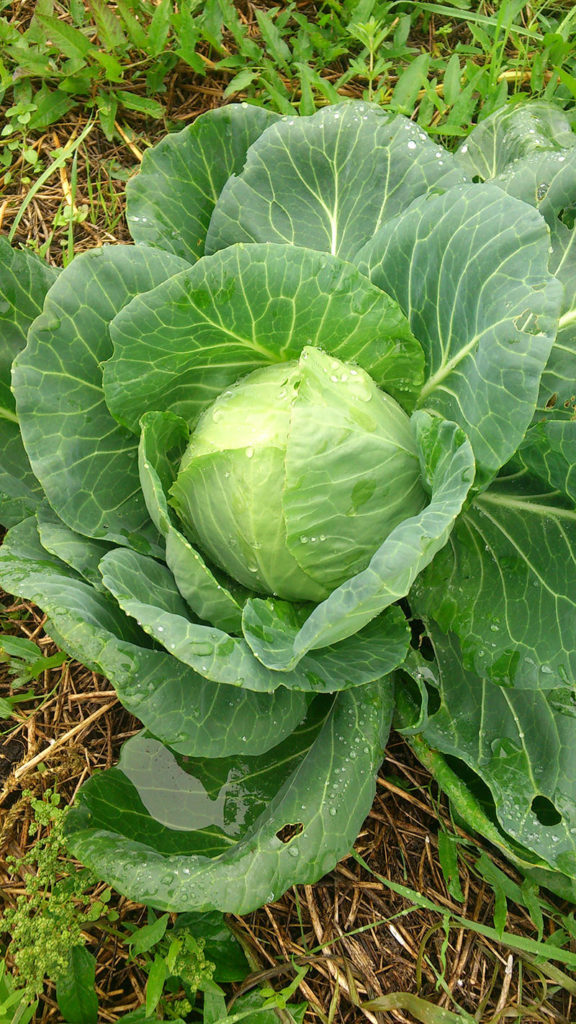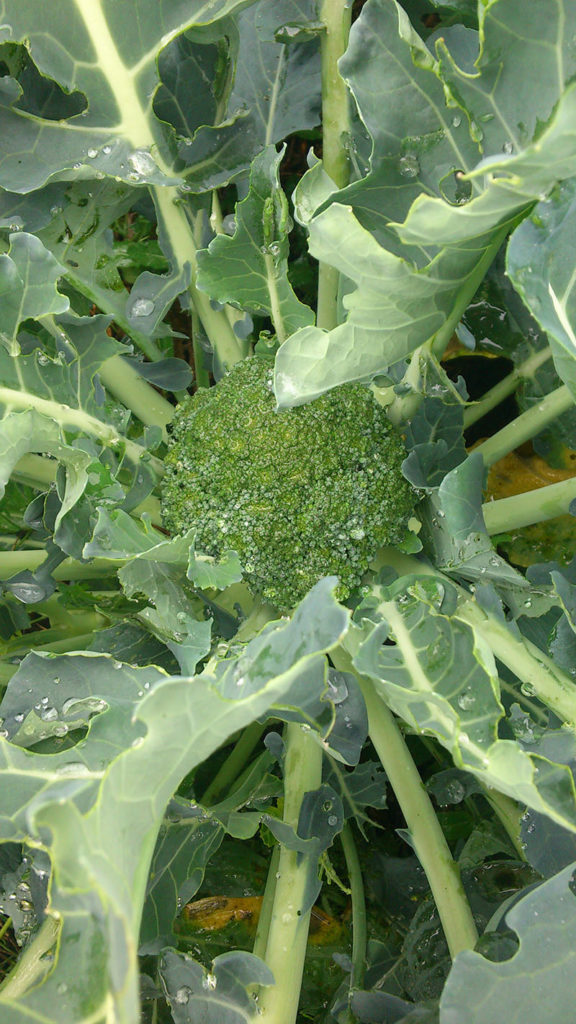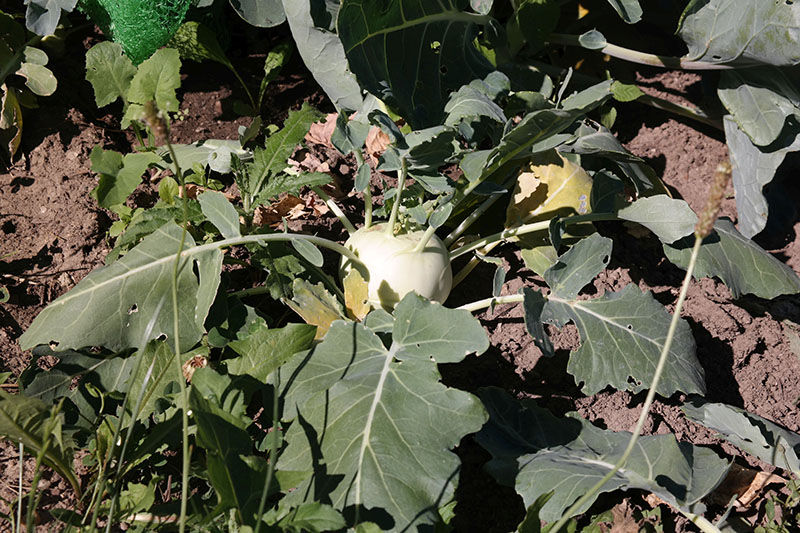Cabbage and Co: these little animals love to eat it
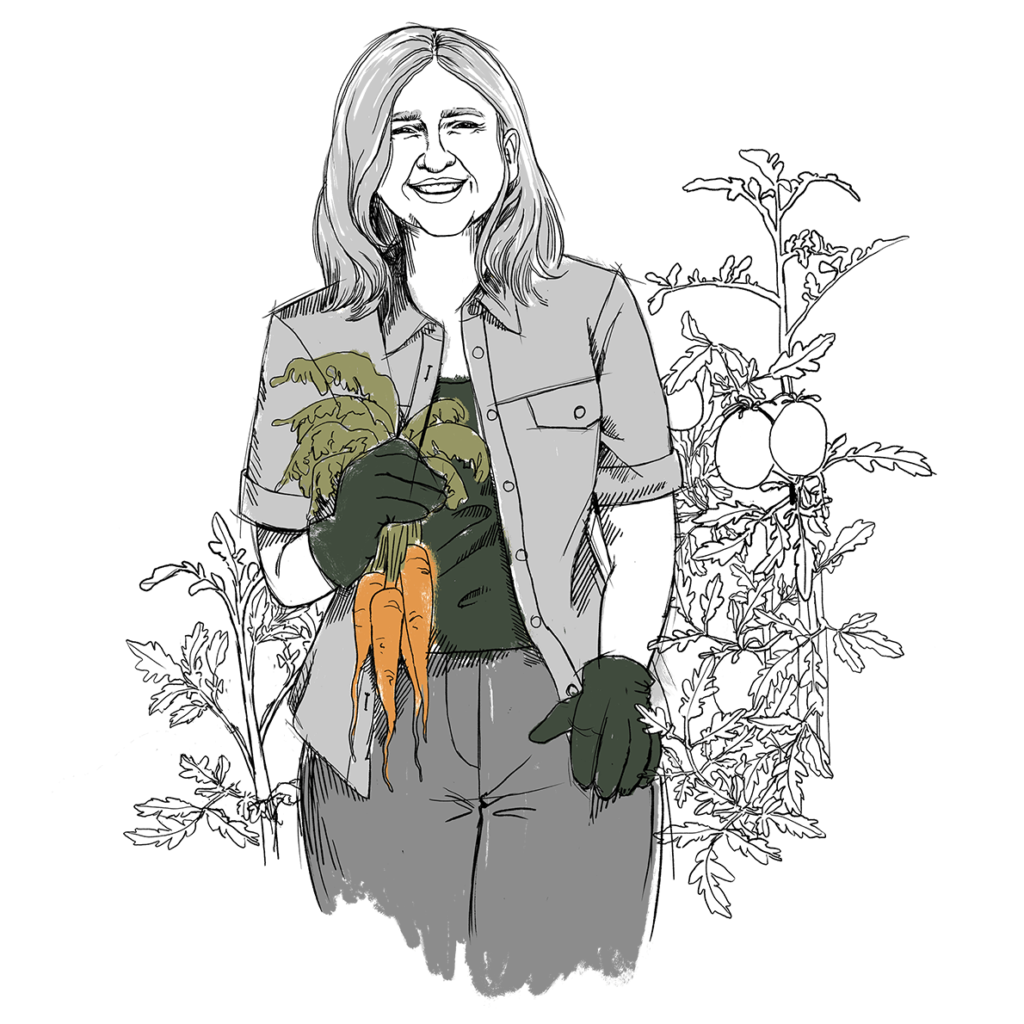
The buffet is properly covered. Delicate, tasty appetizers alternate with light main courses. Suddenly a large group of hungry, uninvited guests comes through the garden door and shamelessly helps themselves. All those little animals can be described in this way or something similar, whose main – or even exclusive meal is plants from the cruciferous family.
Cruciferous plants, or colloquially cabbage plants, are amazingly diverse. Vegetables from this group will certainly grow in your garden. All these plants are botanically very closely related. They contain – in varying proportions and chemical compounds – mustard oil glycosides. These substances are responsible for the somewhat pungent, “cabbagey” taste and the typical smell of cabbage. Unfortunately, this distinctive odor attracts many different pests, which can sense their host plants from a great distance.
To know which plants are threatened by cabbage pests, you can find a list of all cabbage species in the following table:
These animals like to attack cabbage plants particularly
Earth fleas
The name of these annoying little animals is a bit confusing, because they are not fleas but beetles. The flea in the ‘Earth Flea’ points to its big jump-force. If you try to catch the beetle, it will immediately rise.
Damage pattern
In early spring the black or yellow/black striped beetles suddenly appear in flocks and eat small holes in the young leaves of newly sprouted plants. The leaves look like they are pierced with darning needles. As the resistance of the small seedlings is still weak, an earth flea infestation can completely destroy the first sowing of radishes, kohlrabi etc. A second earth flea generation in late summer/autumn causes considerably less damage.

Prevention and defence
Earth fleas like neither humidity nor disturbance of peace. Water your vegetables regularly, preferably early in the morning. Hoe up the soil around the young plants every day. If the disturbance is permanent, the annoying beetles prefer to move to a quieter place. A hard defence is the dusting of rock flour. Scatter it directly over the leaves. The finely ground rock sticks to the chewing tools of the earth fleas and spoils their appetite.
Since earth fleas migrate from the outside, the best defense is prevention. Cover the sowing or freshly planted plants with a fine-meshed insect net. Then the earth fleas have no chance to get to the young plants.
Cabbage Weevils
A few years ago I met this little animal for the first time. In June the leaves of my kohlrabi and cabbage were suddenly covered with felt hundreds of little beetles. After some research I could identify the nimble insects as cabbage weevils.
The cabbage weevils have been appearing more frequently for some years, especially in regions where rapeseed is grown. In spring, the females – which have previously hibernated under leaves or crop residues – lay their eggs in the stems of the rapeseed plants. The larvae feed in them and pupate after some time in the soil. In June the adult beetles hatch. For their ripening food, they attack all cabbage plants in our gardens, among others.
Damage pattern
The insects eat holes in the leaves, often only the upper leaf cells – the “skin” of the leaves – are nibbled off. A heavy infestation can lead to the death of the whole plant.
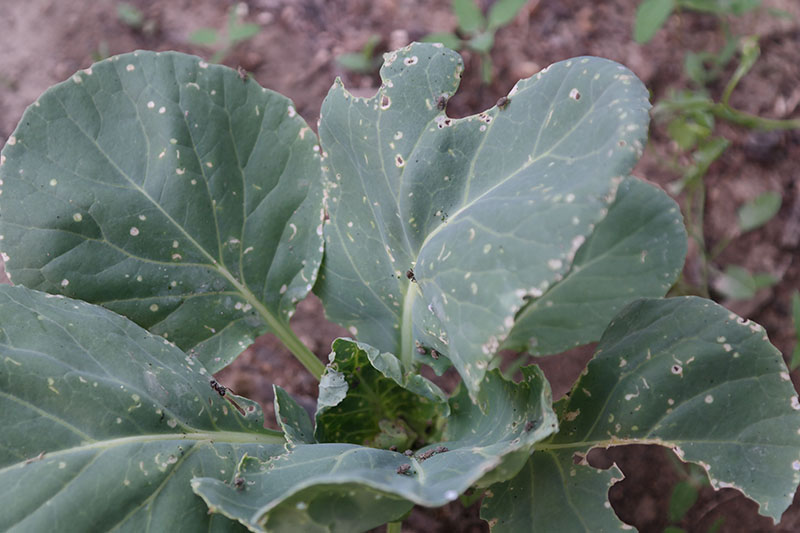
Prevention and defence
The 2-3 mm large, agile beetles drop immediately in case of danger – it is almost impossible to catch them. Direct control is not biologically possible, you can only protect your cabbage as a precaution. Since the beetles migrate from outside, the only effective method is to cover the plants with an insect net in time.
Cabbage Butterfly
In midsummer, therefore from July until August, occasionally also still in September, the adult butterflies of the cabbage butterfly can be seen flying. More exactly said, there are 2 cabbage butterfly-types: the big and the small cabbage butterfly.
The butterflies are white with black wing tips and one (small cabbage butterfly) or two (large cabbage butterfly) black spots on each wing side.
After a conspicuous mating flight, the females lay their eggs on the leaf underside of all cabbage-types, that they can find.
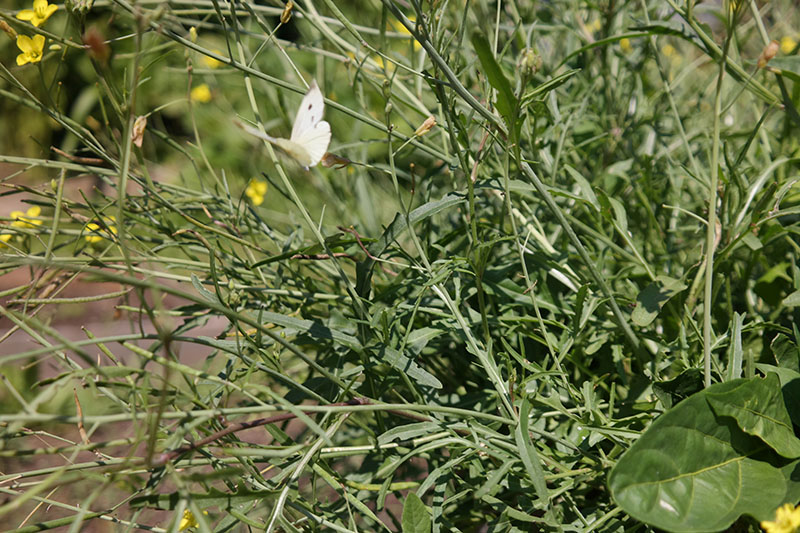
Damage pattern
As soon as the caterpillars have hatched, they begin to eat continuously. Their appetite is so great that within a day they can eat the whole plant bare down to the leaf veins.
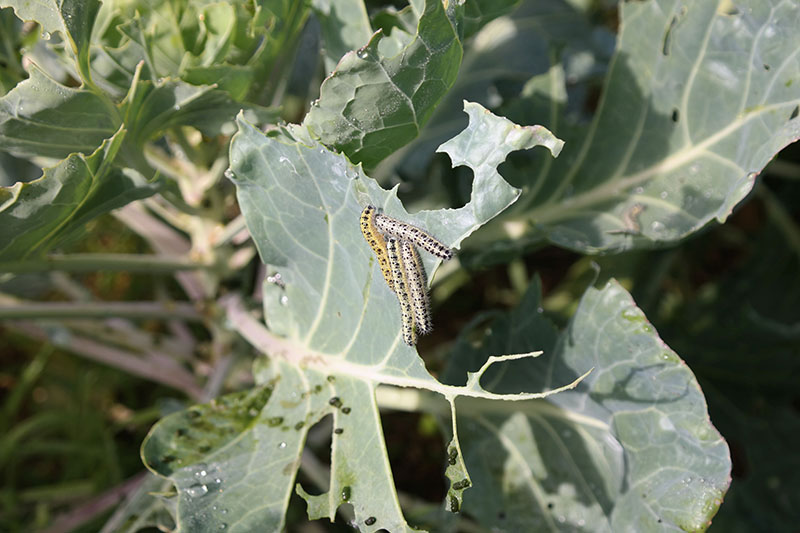
Prevention and defence
The proven insect net helps to prevent the cabbage butterfly from laying its eggs. In summer, however, a heat accumulation can occur under it.
It is better to check your plants regularly for eggs (they are yellowish, oval and grooved) and remove them immediately by hand or with a damp cloth. The eggs are on the underside of the leaves. While the large cabbage butterfly lays whole egg packs, the small cabbage butterfly only lays single eggs – these are easy to miss. Therefore check for caterpillars daily. The small cabbage butterfly has small and green eggs, while the large cabbage butterfly has green and yellow stripes, hairy, with black spots and hard to miss. Be sure to collect the caterpillars with gloves, because they secrete antibodies to which you can react allergic.
White Fly
The white fly is – in contrast to what you might conclude from its name – not a fly, but a louse. The body and wings of the little louse are covered with a white layer of wax. The insect sits on the underside of the leaf and lays its eggs on the spot. If the plant grows, the comfortable White Flies grow “upwards” with it.
Damage pattern
White Flies suck on leaf cells and leaf veins. They secrete the sticky honeydew. The leaves become stained and yellow.
Prevention and defence
The danger that the White Fly travels home with you with on purchased young plants is quite high. Therefore it is better to plant your young plants yourself. As always, an insect net is a good preventive protection.
For direct defense you have several options:
Yellow stickers attract the insects with their bright color. It is best to place or hang the yellow stickers directly next to the affected plants and shake them gently. The White Flies rise up and stick to the glued yellow stickers.
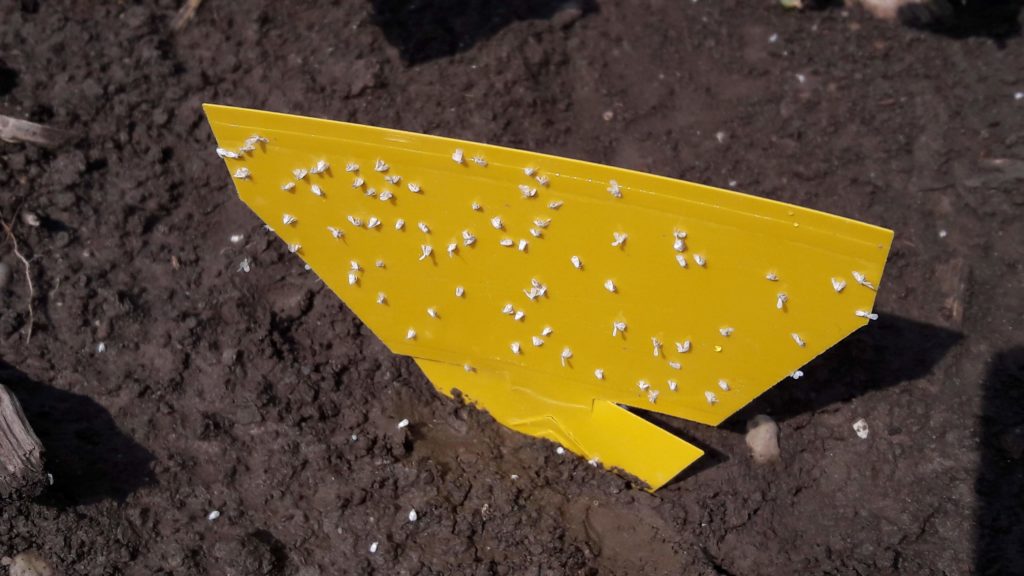
Use specific beneficial insects, e.g. lacewings, predatory mites or chalcid wasps. They all exterminate the White Fly with pleasure.
Cabbage Aphid
There are about 800 species of aphids. Each species has specialized on certain host plants. The cabbage aphid – as its name suggests – is found on cabbage plants.
This aphid is actually green, due to its pollination with white wax it appears grey-blue. In autumn the adult louse lays eggs on wintering cruciferous plants, e.g. winter rapeseed, mustard or winter cabbage. In spring the small aphids hatch and multiply very quickly. Other aphids migrate into your garden from outside. They let themselves be carried by the wind.
Damage pattern
The cabbage aphid feeds on leaves, leaf veins, stems, buds and even on flowers. It thus damages not only the leaves, but also the roses of broccoli or cauliflower.
Prevention and defence
It is important to check in early spring so that you can take measures in time. Small aphid colonies are best removed by wiping with a damp cloth or spraying with a sharp jet of water. Support beneficial insects by providing them with a beneficial host. Feel-good garden in which beneficial insects Ladybirds, lacewings, hoverflies, earwigs and many more find shelter during the cold winter months and they start fighting aphids in time for spring. You can also use specific beneficial insects – you can buy them in specialized stores. In the past, soft soap was often used to control aphids. However, use this only in an extreme emergency, because it destroys not only aphids but also many useful insects.
Cabbage vegetable varieties have become increasingly popular in recent years. Unfortunately not only with us humans, but also with many pests. So make sure you take preventive measures in good time – for most pests, locking them out with a fine-meshed insect net helps. The use of beneficial insects is also a good remedy.
A small consolation at the end: postpone the cultivation of various cabbage vegetables until autumn – because at this time of year most pests are no longer active – and in addition you can look forward to a rich winter harvest! Winter vegetables: cultivate in September – harvest in winter
Article: DI Doris Kampas
Photo credits: bio-garten

